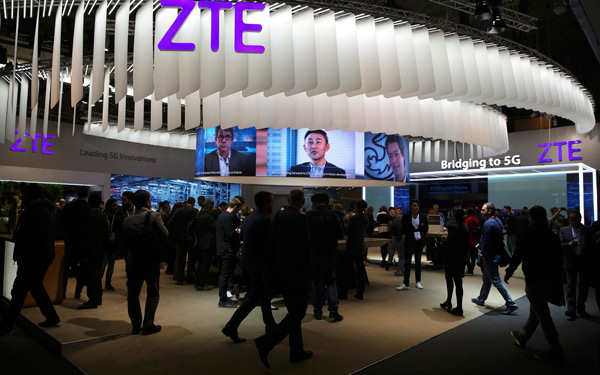 |
|
People stand at ZTE's booth during Mobile World Congress in Barcelona, Spain, February 27, 2017.[Photo/Agencies] |
Continuous government support and industrial capital investments have shaped China as one of the 5G deployment pioneers.
Since the fifth generation mobile networks were highlighted as one of the new emerging industries to be accelerated in the latest Government Work Report, more relevant moves are expected for Chinese authorities to support the industry's R&D.
On March 3, the Ministry of Industry and Information Technology (MIIT) announced the country had established the world's largest 5G test field in the race to standardize the mobile communication technology.
According to Xinhua News Agency, domestic telecom conglomerates Huawei Technologies and ZTE Corp are participating in test programs at the outdoor test site in Beijing.
The latter invests more than 1 billion yuan ($144.5 million) annually on 5G research and development.
From AR/VR and autonomous cars, to the industrial internet and smart cities, 5G is expected to support significantly faster mobile broadband speeds and increasingly extensive mobile data usage -- as well as to enable the full potential of the Internet of Things.
Xu Ming, president of strategy and marketing at ZTE, said telecom operators and businesses must accelerate the adoption of cloud-based technology platforms because of their greater power and flexibility.
The company is currently working on more than 180 network virtualization deployments globally.
At the Mobile World Congress (MWC) 2017 held last month, ZTE released a full range of new 5G base stations.
The company said the new devices use massive multiple input, multiple output (MIMO) (An advanced technique that uses multiple antennas to improve data transmission and reception), beam tracking, beam forming and other key 5G technologies, meeting pre-commercial deployment requirements for 5G.
"Most of the world's top operators are tending to roll out new base stations and new networks equipped with small and efficient implements," said Jean-Claude Loirat, director of EMEA Operations Radio Frequency, NXP, one of the chip makers that has worked closely with domestic carriers to deploy 5G-ready applications in China's market.
"Through our integrated products dedicated to the massive MIMO technology, customers like China Mobile are able to start building its 5G networks," Loirat said. "The latency of the network needs to be lower than what we have achieved today in a 4G environment".
According to Loirat, China is highly likely to be at the forefront of 5G deployment, and he believes 5G commercialization will be set around 2019.
Although the commercialization of 5G services is becoming imminent, protecting carrier investment in 4G and enabling a smooth transition to 5G is also important to the carriers who have invested heavily in R&D in 4G.
Kalvin Peng, head of R&D, Ericsson North East Asia, said 5G service will be gradually deployed in some specific scenarios at first, rather than being extensively implemented around the entire country.
Although the market is facing fierce competition for telecom communication providers, Peng said there is no end to improving high-speed and low-latency networks, and the passion will lead the development of the industry, accelerate industrial incubation, achieve higher business scales and feed customers' sweet spots.